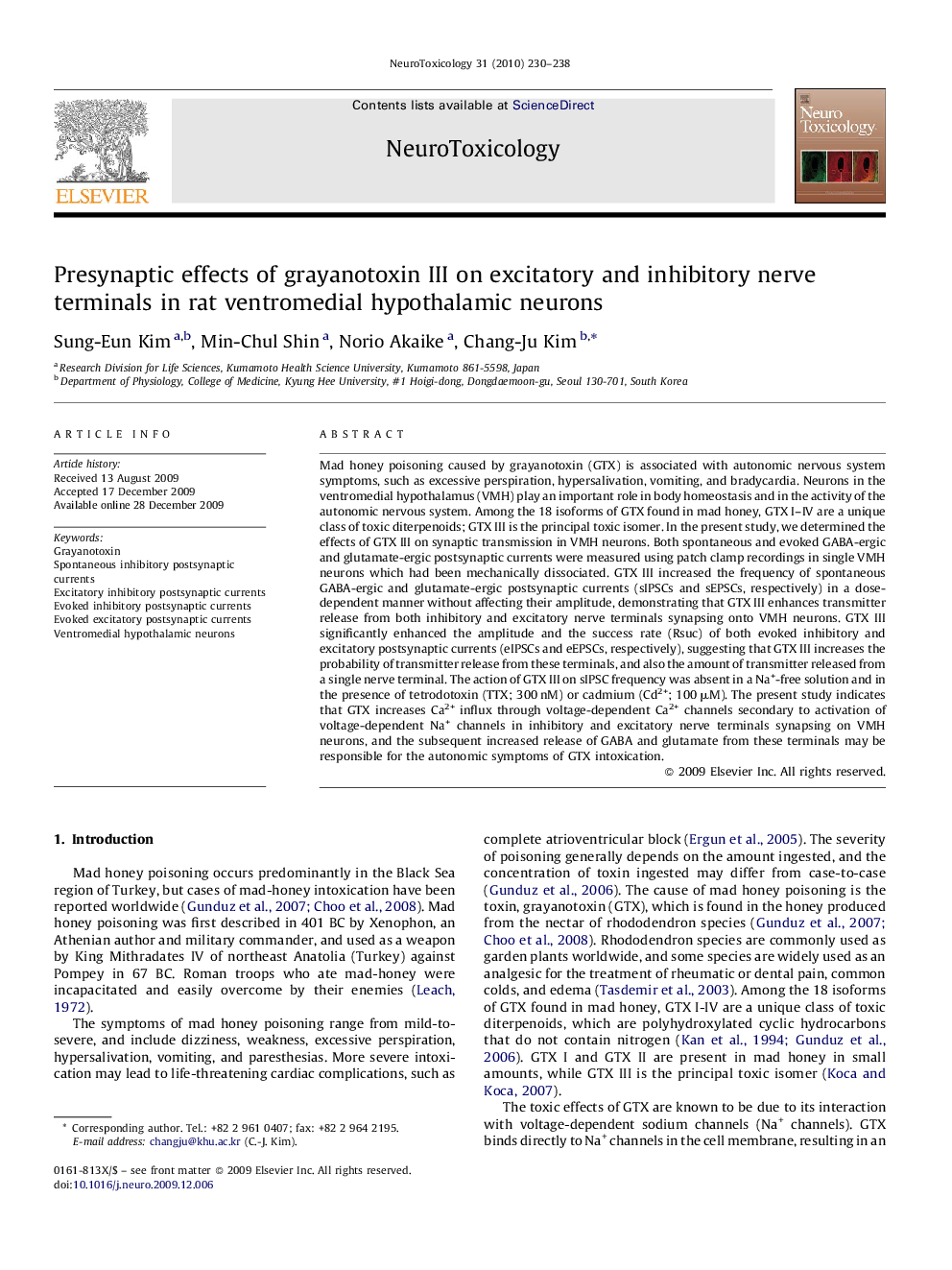| کد مقاله | کد نشریه | سال انتشار | مقاله انگلیسی | نسخه تمام متن |
|---|---|---|---|---|
| 2590648 | 1131757 | 2010 | 9 صفحه PDF | دانلود رایگان |
عنوان انگلیسی مقاله ISI
Presynaptic effects of grayanotoxin III on excitatory and inhibitory nerve terminals in rat ventromedial hypothalamic neurons
دانلود مقاله + سفارش ترجمه
دانلود مقاله ISI انگلیسی
رایگان برای ایرانیان
کلمات کلیدی
موضوعات مرتبط
علوم زیستی و بیوفناوری
علوم محیط زیست
بهداشت، سم شناسی و جهش زایی
پیش نمایش صفحه اول مقاله

چکیده انگلیسی
Mad honey poisoning caused by grayanotoxin (GTX) is associated with autonomic nervous system symptoms, such as excessive perspiration, hypersalivation, vomiting, and bradycardia. Neurons in the ventromedial hypothalamus (VMH) play an important role in body homeostasis and in the activity of the autonomic nervous system. Among the 18 isoforms of GTX found in mad honey, GTX I-IV are a unique class of toxic diterpenoids; GTX III is the principal toxic isomer. In the present study, we determined the effects of GTX III on synaptic transmission in VMH neurons. Both spontaneous and evoked GABA-ergic and glutamate-ergic postsynaptic currents were measured using patch clamp recordings in single VMH neurons which had been mechanically dissociated. GTX III increased the frequency of spontaneous GABA-ergic and glutamate-ergic postsynaptic currents (sIPSCs and sEPSCs, respectively) in a dose-dependent manner without affecting their amplitude, demonstrating that GTX III enhances transmitter release from both inhibitory and excitatory nerve terminals synapsing onto VMH neurons. GTX III significantly enhanced the amplitude and the success rate (Rsuc) of both evoked inhibitory and excitatory postsynaptic currents (eIPSCs and eEPSCs, respectively), suggesting that GTX III increases the probability of transmitter release from these terminals, and also the amount of transmitter released from a single nerve terminal. The action of GTX III on sIPSC frequency was absent in a Na+-free solution and in the presence of tetrodotoxin (TTX; 300 nM) or cadmium (Cd2+; 100 μM). The present study indicates that GTX increases Ca2+ influx through voltage-dependent Ca2+ channels secondary to activation of voltage-dependent Na+ channels in inhibitory and excitatory nerve terminals synapsing on VMH neurons, and the subsequent increased release of GABA and glutamate from these terminals may be responsible for the autonomic symptoms of GTX intoxication.
ناشر
Database: Elsevier - ScienceDirect (ساینس دایرکت)
Journal: NeuroToxicology - Volume 31, Issue 2, March 2010, Pages 230-238
Journal: NeuroToxicology - Volume 31, Issue 2, March 2010, Pages 230-238
نویسندگان
Sung-Eun Kim, Min-Chul Shin, Norio Akaike, Chang-Ju Kim,